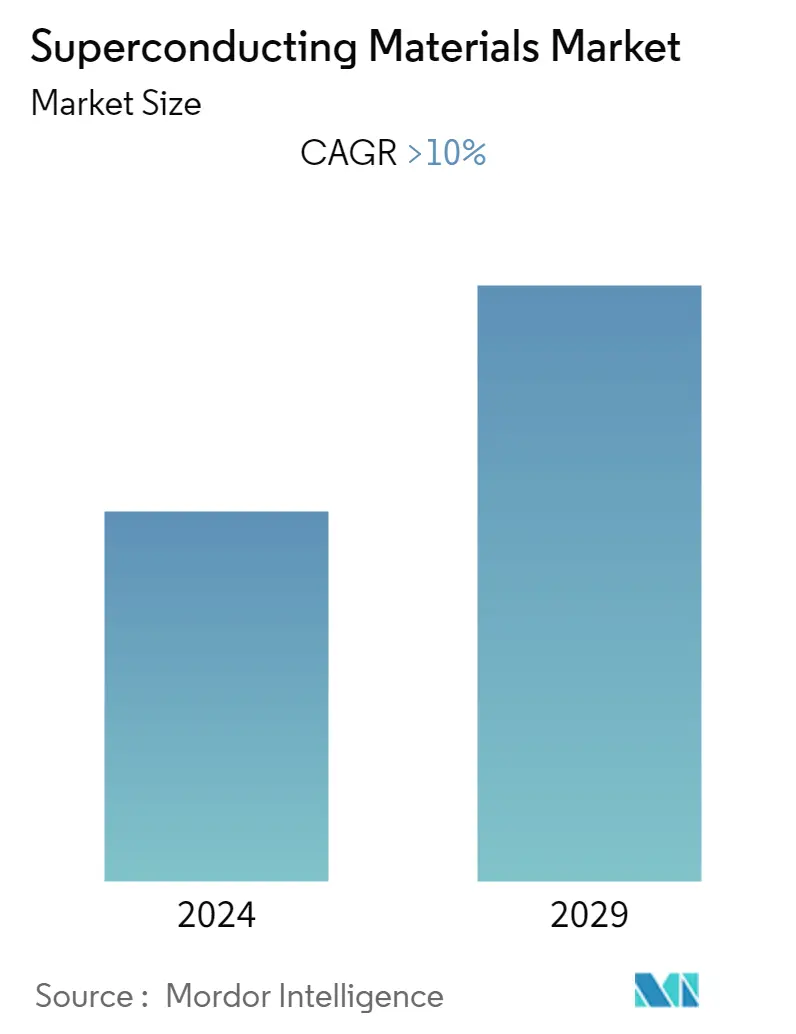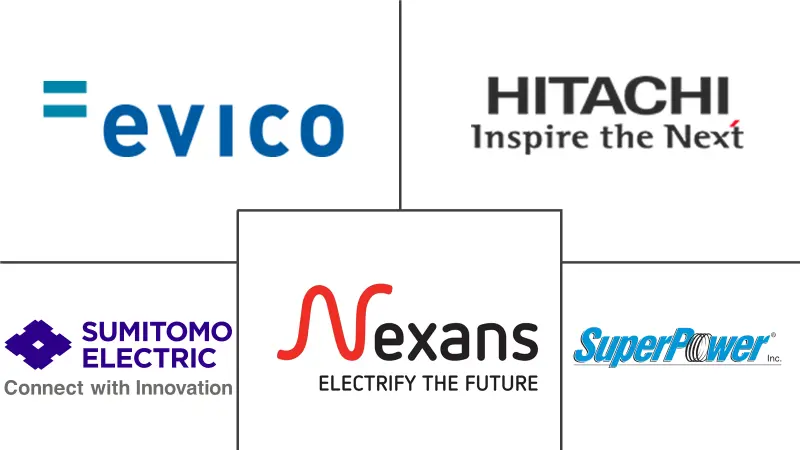Market Size of Superconducting Materials Industry

| Study Period | 2019 - 2029 |
| Base Year For Estimation | 2023 |
| CAGR | 10.00 % |
| Fastest Growing Market | Asia Pacific |
| Largest Market | North America |
| Market Concentration | Medium |
Major Players
*Disclaimer: Major Players sorted in no particular order |
Superconducting Materials Market Analysis
The global superconducting materials market is expected to grow with a CAGR greater than 10% during the forecast period.
The COVID-19 pandemic negatively hampered the global superconducting materials market growth due to considerable disruption in the supply chain activities and reduced the production of commodities, goods, and services. However, the industry witnessed a recovery in 2021, thus rebounding the demand for the market studied.
- Increasing expenditures on medical machinery and equipment are driving the market.
- On the flip side, inadequate availability of feedstock materials such as Yttrium is hindering the growth of the market studied.
- However, the potential to bring changes to electric power and high-field magnet technology shall create a lucrative opportunity in the future.
- Asia-Pacific accounted for the highest share of the market and is likely to continue dominating the market during the forecast period.
Superconducting Materials Industry Segmentation
Superconducting materials refer to various metallic compounds or alloys that can conduct electricity/ electric charge with no resistance and without releasing heat, sound, and energy. Common superconducting materials include gallium, cadmium, aluminum, vanadium, zinc, tungsten, thorium, lead, titanium, and lanthanum. These materials are available in powders or crystals, magnets, wires, and cables. They are widely used in power storage devices, grids, electric motors, magnetic levitation trains, magnetic resonance imaging (MRI), and electromagnetic generators. The superconducting materials market is segmented by product type and end-user industry. By product type, the market is segmented into low-temperature superconducting materials and high-temperature superconducting materials. By end-user industry, the market is segmented into medical, electronics, and other end-use industries. The report also covers the market size and forecasts for the superconducting materials market in 11 countries across major regions. The market sizing and forecasts have been done for each segment based on value (USD million).
| Product Type | |
| Low-temperature Superconducting Materials (LTS) | |
| High-temperature Superconducting Materials (HTS) |
| End-user Industry | |
| Medical | |
| Electronics | |
| Other End-user Industries |
| Geography | |||||||
| |||||||
| |||||||
| |||||||
| Rest of the World |
Superconducting Materials Market Size Summary
The superconducting materials market is poised for significant growth, driven by increasing investments in medical machinery and equipment. The market experienced a setback due to the COVID-19 pandemic, which disrupted supply chains and reduced production. However, it rebounded in 2021, with the medical sector currently holding the largest market share. The demand for superconducting materials is particularly high in magnetic resonance imaging (MRI) machines, which require these materials to maintain large magnetic fields. The aging population in North America, coupled with substantial healthcare expenditures, is expected to sustain demand in this region. Meanwhile, developing countries are also ramping up medical sector investments, further bolstering market growth.
In the Asia-Pacific region, the demand for superconducting materials is on the rise, fueled by the burgeoning electrical and electronics industry. Countries like China and India are experiencing robust growth due to favorable government policies supporting production increases. The region's medical industry has also seen significant expansion, contributing to the market's growth trajectory. Despite challenges such as the inadequate availability of feedstock materials, the potential for advancements in electric power and high-field magnet technology presents lucrative opportunities. The market is moderately consolidated, with key players like evico GmbH, Hitachi, Ltd., and Sumitomo Electric Industries, Ltd. actively participating in research and development to enhance superconducting technologies.
Superconducting Materials Market Size - Table of Contents
-
1. MARKET DYNAMICS
-
1.1 Drivers
-
1.1.1 Increasing Expenditures on Medical Machinery and Equipment
-
1.1.2 Growing Demand from the Electronics Industry
-
-
1.2 Restraints
-
1.2.1 Inadequate Availability of Feedstock Materials such as Yttrium
-
-
1.3 Industry Value-chain Analysis
-
1.4 Porter's Five Forces Analysis
-
1.4.1 Bargaining Power of Suppliers
-
1.4.2 Bargaining Power of Buyers/Consumers
-
1.4.3 Threat of New Entrants
-
1.4.4 Threat of Substitute Products and Services
-
1.4.5 Degree of Competition
-
-
-
2. MARKET SEGMENTATION (Market Size in Value)
-
2.1 Product Type
-
2.1.1 Low-temperature Superconducting Materials (LTS)
-
2.1.2 High-temperature Superconducting Materials (HTS)
-
-
2.2 End-user Industry
-
2.2.1 Medical
-
2.2.2 Electronics
-
2.2.3 Other End-user Industries
-
-
2.3 Geography
-
2.3.1 Asia-Pacific
-
2.3.1.1 China
-
2.3.1.2 India
-
2.3.1.3 Japan
-
2.3.1.4 South Korea
-
2.3.1.5 Rest of Asia-Pacific
-
-
2.3.2 North America
-
2.3.2.1 United States
-
2.3.2.2 Canada
-
2.3.2.3 Mexico
-
-
2.3.3 Europe
-
2.3.3.1 Germany
-
2.3.3.2 United Kingdom
-
2.3.3.3 Italy
-
2.3.3.4 France
-
2.3.3.5 Rest of Europe
-
-
2.3.4 Rest of the World
-
-
Superconducting Materials Market Size FAQs
What is the current Superconducting Materials Market size?
The Superconducting Materials Market is projected to register a CAGR of greater than 10% during the forecast period (2024-2029)
Who are the key players in Superconducting Materials Market?
evico GmbH, Hitachi, Ltd. , SuperPower Inc., Sumitomo Electric Industries, Ltd. and NEXANS are the major companies operating in the Superconducting Materials Market.

